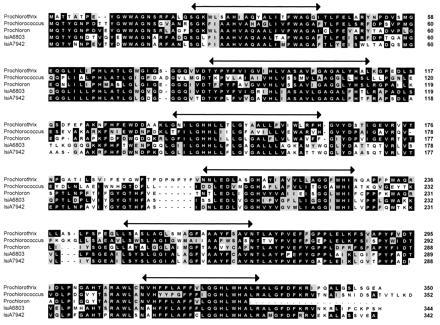Figure 1.

Alignment of protein sequences deduced from nucleotide sequences of the pcb genes of the prochlorophytes P. hollandica (pcbA), Prochlorococcus sp. CCMP 1378 (Med strain), and P. didemni, and the isiA genes of the cyanobacteria Synechocystis sp. PCC6803 and Synechococcus sp. PCC7942. Identical residues are in white type on a black background; gray squares are either conservative substitutions (within the groups FILMV, FYW, AG, HNQ, EQ, and DN) or columns where two different amino acids were found in both pcb and isiA proteins. Identity of cloned genes was confirmed by comparison with peptide sequences. Tryptic and N-terminal sequences determined from purified Chl a/b-binding protein P32 of P. hollandica were (2)ATTATPEYG(10), (112)GPEDLXQXDFEFA(124), (126)NFPFEWDDAAQA(137), (286)FSVAPYFVDTIDLPNGA(302), and (341)ALGFDFK(347). N-terminal sequence from the 32-kDa polypeptide of Prochlorococcus sp. (Med) was (1)MQTYGNPDVTYGXXAGN(17). Partial Lys-C digests of the 34-kDa Chl a/b protein of P. didemni gave the peptides (K)E(1)MQTYGNPDVEYGXXAGNSRLA and 118(K)EGPARAPKFDFDXGDGKXLGFI(140). The two additional amino acids consistently detected in the first peptide suggest that the P. didemni protein has an N-terminal extension not found in any other members of the family. The numbers flanking the peptide sequences correspond to residue numbers in the alignment. Double-headed arrows are predicted membrane-spanning helices.
